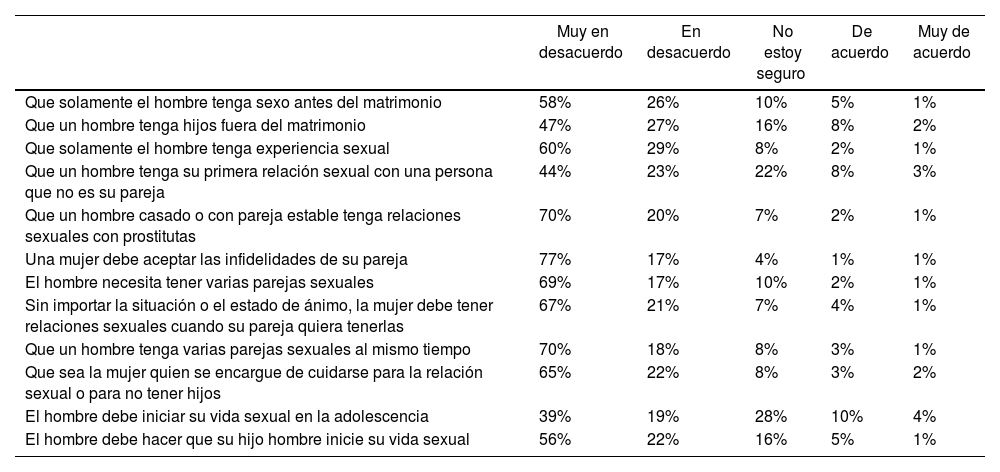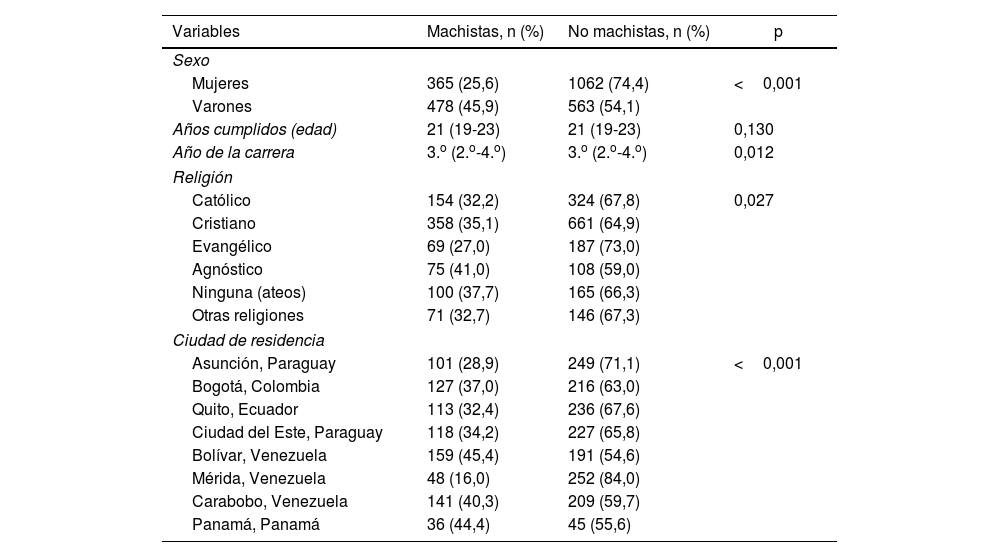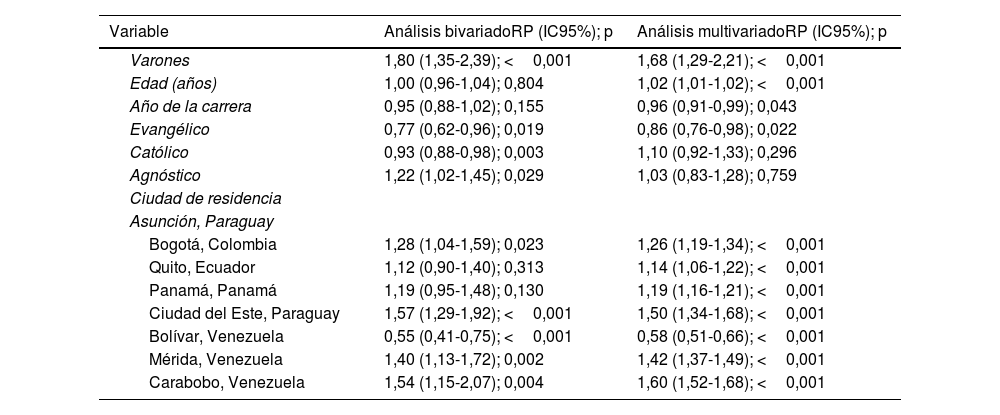
Número especial: Avances y retos en la psiquiatría regional en Latinoamérica
Más datosEl machismo es un problema profundamente arraigado en la sociedad latinoamericana, pero esto no se ha medido en el contexto de los futuros profesionales de la salud. El objetivo es identificar los factores asociados con el machismo en estudiantes de Medicina de 8 ciudades de 5 países de Latinoamérica.
MétodosEstudio transversal analítico y multicéntrico. Se encuestó a 2.468 estudiantes de Medicina humana en 5 países de Latinoamérica. El machismo se midió con una escala validada (α=0,89), se cruzó con otras variables socioeducativas importantes y se obtuvieron estadísticas analíticas a través de los modelos lineales generalizados.
ResultadosEn el análisis multivariado del machismo, la mayor frecuencia se presentó entre los varones (RP=1,68; IC95%: 1,29-2,21; p<0,001) y a mayor edad (RP=1,02; IC95%, 1,01-1,02; p <0,001); en cambio, hubo menor frecuencia a mayor nivel académico (RP=0,96; IC95%, 0,91-0,99; p=0,043) y entre los que profesaban la religión evangélica (RP=0,86; IC95%, 0,76-0,98; p=0,022). En comparación con los estudiantes de Asunción, los de Bogotá tuvieron una mayor frecuencia de machismo ajustada por 3 variables (RP=1,26; IC95%, 1,19-1,34; p <0,001) que los de Quito (RP=1,14; IC95%, 1,14; 1,06-1,22; p <0,001), Panamá (RP=1,19; IC95%, 1,16-1,21; p <0,001), Ciudad del Este (RP=1,50; IC95%, 1,34-1,68; p <0,001), Mérida (RP=1,42; IC95%, 1,37-1,49; p <0,001) y Carabobo (RP=1,60; IC95%, 1,52-1,68; p <0,001); sin embargo, los de Bolívar tenían menos machismo (RP=0,58; IC95%, 0,51-0,66; p <0,001).
ConclusionesSe encontraron factores importantes asociados con el machismo entre los estudiantes de Medicina, los más importantes el sexo, la edad, el año académico, la religión y el país de residencia.
Machismo is a deeply rooted problem in Latin American society, but this has not been measured in the context of future health professionals. The objective was to identify factors associated with machismo among medical students from eight cities in five Latin American countries.
MethodsAn analytical cross-sectional multicentre study was conducted. A total of 2,468 students of human medicine in five Latin American countries were surveyed. Machismo was measured with a validated scale (α=0.89) and cross-checked against other important social and educational variables. Analytical statistics were derived from generalised linear models.
ResultsAccording to the multivariate analysis, machismo occurred at the highest rate among men (prevalence ratio [PR] 1.68; 95% CI 1.29-2.21; p <0.001) and at an older age (PR 1.02; 95% CI 1.01-1.02; p <0.001), whereas it occurred at lower rates at a higher level of academic study (PR 0.96; 95% CI 0.91-0.99; p=0.043) and among those who claimed to belong to an evangelical religion (PR 0.86; 95% CI 0.76-0.98; p=0.022). Compared to students from Asunción, those from Bogotá had a higher rate of machismo adjusted for three variables (PR 1.26; 95% CI, 1.19-1.34; p <0.001) than those from Quito (PR 1.14; 95% CI, 1.06-1.22; p <0.001), those from Panama City (PR 1.19; 95% CI, 1.16-1.21; p <0.001), those from Ciudad del Este (PR 1.50; 95% CI, 1.34-1.68; p <0.001), those from Mérida (PR 1.42; 95% CI, 1.37-1.49; p <0.001) and those from Carabobo (PR 1.60; 95% CI, 1.52-1.68; p <0.001); however, those from Bolívar had less machismo (PR 0.58; 95% CI, 0.51-0.66; p <0.001).
ConclusionsFactors significantly associated with machismo were found among medical the students studied; the most important ones were sex, age, academic year, religion and country of residence.
Artículo
Comprando el artículo el PDF del mismo podrá ser descargado
Precio 19,34 €
Comprar ahora








